Exploring the Science Behind Wrinkled Fingertips
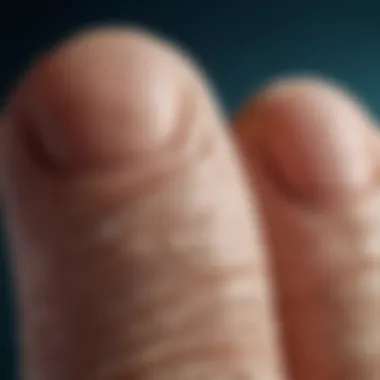
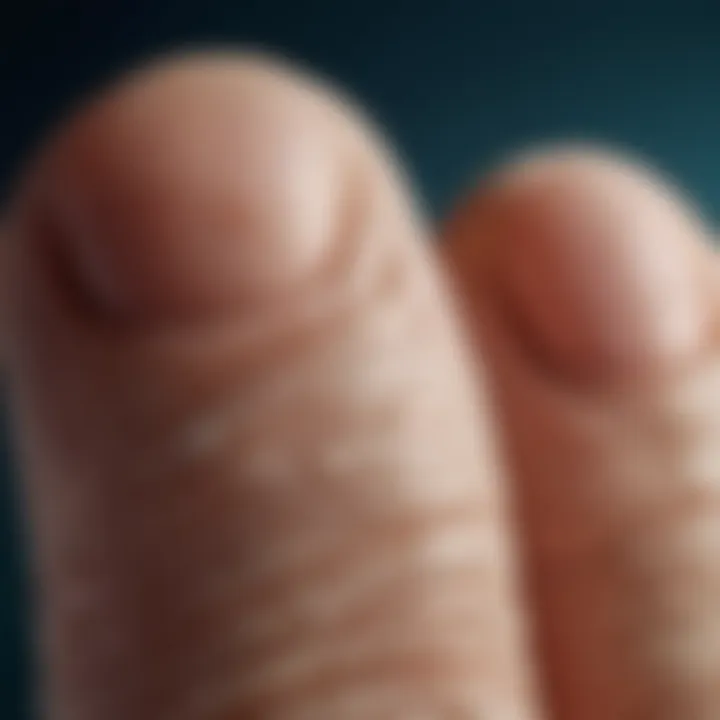
Intro
Wrinkled fingertips, often dismissed as a mere aesthetic hiccup, can tell a deeper story about our bodies and the environments we inhabit. From the moment you dip your fingers into the ocean to enjoy a sun-soaked day at the beach, it may seem like just another quirk of nature. Yet, this phenomenon opens a window into several compelling contexts, illuminating a variety of aspects from biology to culture.
When you spend time in water, you’ll notice your fingertips start to form those distinctive wrinkles. This process, scientifically known as maceration, serves a purpose beyond what’s visible. In this article, we will take a thorough look at how environmental factors, like water immersion, can affect our skin's appearance and functionality. The implications extend beyond casual swimming sessions; surfers, lifeguards, and marine biologists can all gain insights into how wrinkling may influence grip and sensation in wet conditions.
As we move along, it’s also essential to consider the nuances of surfing culture and how this physical reaction plays a role in a surfer’s experience. We'll address practical concerns and offer a detailed exploration of how wrinkled fingertips might change the game in surfing. Not only will we dive into physiological mechanisms, but we will also outline traditional and contemporary surfing techniques, along with insights for beginners and experienced surfers alike.
Let’s embark on this unique journey, where science meets the sea, and wrinkled fingertips become a symbol of deeper interactions with our aquatic environment.
Prelude to Wrinkled Fingertips
In the realm of human physiology, some peculiar phenomena often linger in the shadows, waiting to be fully understood. One such enigma is the wrinkling of fingertips, a phenomenon that triggers curiosity and warrants exploration. This section aims to shed light on the significance of understanding wrinkled fingertips, illuminating elements that are particularly relevant for surfers, instructors, beach lifeguards, outdoor writers, and marine biologists.
Understanding the intricacies behind fingertip wrinkling serves multiple purposes. First and foremost, it grants us insights into how our bodies adapt to environmental conditions. This is critical knowledge not only for individuals engaged in aquatic activities but also for professionals who might need to mitigate adverse effects on skin integrity. By delving into the nature of this occurrence, we uncover the relationship between physical interactions—like water exposure—and biological responses.
Whether surfing off the coast of California or teaching a group of children how to swim, comprehending why fingers become wrinkled during prolonged contact with water is both practical and pertinent to those engaged in such activities. It can also guide them in adopting strategies that safeguard their skin while maintaining performance. For instance, surfers are often in the water for extended periods, and understanding the mechanics of fingertip wrinkling could help them adjust their habits or utilize protective gear to minimize discomfort.
In addition to the practical implications, there is an underlying cultural significance tied to this topic. Wrinkled fingertips have seeped into various leisure activities, serving as a subtle badge of honor among enthusiasts. In a way, they represent not just the engagement with the ocean, but the joys and challenges faced by those who explore its depths.
As we navigate through this article, we will explore key aspects of this phenomenon in detail, including the biological mechanisms, common scenarios, and even cultural implications. This journey promises to not only inform but also enrich the understanding of a seemingly simple, yet deeply complex, bodily response.
Nature of the Phenomenon
Fingertip wrinkling is primarily an adaptation response. When skin is submerged in water, the outer layer, known as the stratum corneum, absorbs moisture. This leads to a temporary elongation of the skin, causing the characteristic wrinkled appearance. The autonomic nervous system plays a key role in this mechanism, indicating that this physiological response is not merely passive but rather a function of our body’s reflexive actions to various stimuli.
Interestingly, research suggests that this wrinkling is advantageous. It increases grip on wet surfaces, thus reducing the likelihood of slips and falls—a crucial benefit for those maneuvering through wet conditions, like surfers and lifeguards. This insight presents a practical avenue for those interested in human anatomy or occupational safety in aquatic environments.
Common Scenarios of Occurrence
Wrinkled fingertips can emerge under a variety of circumstances, often driven by the environment. The most obvious scenario is, of course, extended exposure to water, such as swimming, surfing, or even doing dishes. Each instance offers a slightly different context for the phenomenon:
- Swimming and Surfing: When athletes engage in water sports, their hands are frequently dunked, leading to rapid wrinkling. This adaptation facilitates a better grip on boards or equipment.
- Marine Research: Marine biologists often find themselves handling aquatic species or conducting research in water. Prolonged contact can lead to the same wrinkling, a consideration that might affect their fieldwork efficiency.
- Household Chores: The mundane task of washing dishes or immersing oneself in a bath can also trigger this response, revealing just how universal and accessible this biological phenomenon is.
In summary, wrinkled fingertips are more than just a curious bodily function; they offer insights into environmental interactions while serving practical purposes for those frequently engaged in aquatic settings. Understanding this complexity not only enriches our appreciation of human biology but also fosters a greater awareness of the interdependence between our bodies and the environments we immerse ourselves in.
Biological Mechanisms Behind Fingertip Wrinkling
Understanding the biological mechanisms behind fingertip wrinkling is essential to grasp why this phenomenon occurs as well as its implications in various contexts, especially for those involved in water-related activities like surfing. This section highlights the interplay between our body's nervous system, skin hydration, and age-related changes, all of which play significant roles in how our fingertips react under different conditions.
Role of the Nervous System
The neurophysiological aspect of skin wrinkling is often overlooked yet holds the key to how our fingertips respond to external stimuli. Fingertips have a high density of nerve endings, allowing these areas to transmit information about their environment promptly. When submerged in water, the nervous system detects the change in temperature and texture, signaling the body to react accordingly.
This reaction is thought to be an evolutionary adaptation, enhancing grip in wet conditions.
- Innervation: The intricate network of nerves works to control the skin's response. When the fingers are exposed to moisture for a prolonged period, the autonomic nervous system activates.: .important
- Vasoconstriction: A contraction of blood vessels occurs, leading to a redistribution of fluid in the fingers. This can cause the skin to wrinkle as it compensates for the changes in pressure.
Studies have shown that this wrinkling effect is not just about aesthetics; it can serve a functional purpose. Increased grip on wet surfaces may have provided an advantage to our ancestors. This biological response emphasizes how fundamentally intertwined our biology is with even the most mundane environments.
Hydration and Skin Physiology
Moving to hydration, the skin's ability to retain water plays a crucial role in how fingers change their appearance during and after exposure to water. The epidermis, or outer layer of skin, consists of hydrophilic cells that attract moisture. When submerged, these cells absorb water, leading to swelling.
- Stratum Corneum: This top layer of skin becomes more pliable when hydrated, creating the initial changes in texture. As water permeates this layer, it expands and spreads out, creating folds and wrinkles.
- Skin Barrier Function: The skin's barrier is crucial for maintaining hydration levels. If this barrier is compromised, either by age or environmental factors, the skin tends to lose moisture more rapidly, leading to more pronounced wrinkling.
It’s important to note that excessive water exposure, especially in saltwater conditions as often found in surfing, can also strip the skin of its natural oils. Therefore, the balance of hydration is vital to maintain smooth and healthy skin.
Impact of Age on Skin Texture
Aging brings about natural changes in skin physiology that contribute to the appearance of wrinkled fingertips. With time, the skin undergoes several transformations that affect its texture and elasticity, which are particularly visible in fingertip skin.
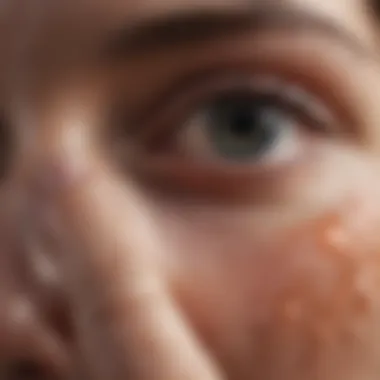
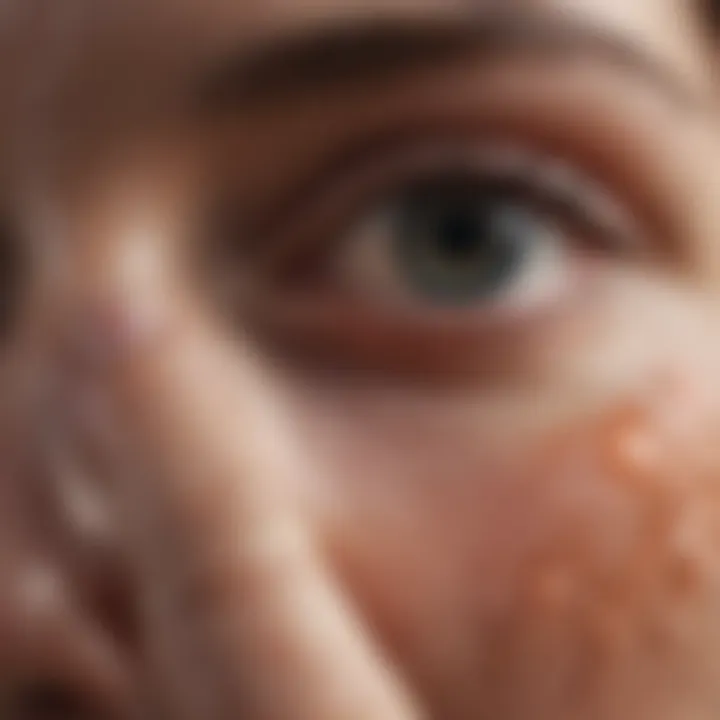
- Collagen and Elastin Decline: As we age, the production of collagen and elastin—two proteins essential for skin elasticity—decreases. This decline can lead to thinner skin that is more susceptible to wrinkling.
- Cell Turnover Rate: The body's natural ability to shed and renew skin cells slows down with age, making older skin appear dull and less resilient.
- Hydration Levels: Older adults often experience drier skin due to hormonal changes, which can exacerbate the wrinkling effect. Decreased oil production can lead to a loss of suppleness, particularly noticeable in areas subjected to various environmental factors.
Environmental Influences on Skin Texture
Understanding how different environmental factors influence skin texture, specifically regarding wrinkled fingertips, is essential. Surfers and outdoor enthusiasts often encounter various conditions that can significantly impact skin health and appearance. This section delves into two primary influencers: the effects of water exposure and the interplay of temperature and humidity.
Effects of Water Exposure
Water exposure is a primary contributor to fingertip wrinkling, with its effects evident right after prolonged contact. This phenomenon occurs due to the skin's outermost layer, the stratum corneum, absorbing water and swelling. The excess fluid creates a physical change in skin texture. For surfers, this is almost a daily occurrence. When hands are submerged in seawater or even fresh water for extended periods, the results are seen almost immediately.
Key Considerations regarding Water Exposure:
- Duration of Exposure: The length of time spent in water directly correlates with the depth of wrinkling. A quick dip may result in minimal change, but hours spent surfing can lead to pronounced wrinkles.
- Type of Water: Saltwater often has a more pronounced effect compared to fresh water. The minerals and salinity may cause the skin to react differently, leading to a unique wrinkling pattern.
- Skin Health: Individuals with pre-existing skin conditions may notice increased wrinkling or irritation as their skin interacts with water for extended periods.
"Understanding the nuances of water exposure helps surfers manage their skin and anticipate changes in texture, allowing them to continue enjoying their passion without unnecessary concerns."
Temperature and Humidity Effects
Temperature and humidity are also crucial players in the visual and physical quality of fingertips. Skin behaves distinctly at various temperatures; warmer environments tend to increase moisture evaporation. This interaction can lead to drier skin, which, paradoxically, may cause it to wrinkle more as it seeks to retain some moisture.
The combination of high humidity and heat can result in a different response. Under humid conditions, skin retains more moisture. Initially, this might seem beneficial, but over time, the constant moisture can lead to skin softening and wrinkling, especially in areas frequently submerged in water.
Practical Considerations for Temperature and Humidity Effects:
- Monitoring Conditions: For surfers and lifeguards, being aware of weather can assist in preparing skin care strategies. Hot, humid days require different care compared to colder, drier ones.
- Adaptive Skin Care: Using moisturizers that cater to current conditions can help. In high humidity, light, oil-free products may be ideal, while drier conditions may warrant a more nourishing cream.
By comprehending how environmental factors play into fingertip wrinkling, individuals can make informed decisions regarding their skin care. Whether it's surf conditions or the finest details of weather changes, these insights allow surfers and outdoor enthusiasts to enjoy their activities while managing their skin health effectively.
Cultural Significance of Wrinkled Fingertips
Understanding wrinkled fingertips goes beyond biology and physiology; it taps into a larger cultural narrative that intertwines with everyday life, leisure, and even historical contexts. The appearance of wrinkled skin, despite its seemingly trivial nature, has implications that echo through different societies and activities. In many cases, this skin condition acts as a silent testament to human experience, reflecting intense moments that shape our interactions with our environment.
Historical Perspectives on Skin Changes
Throughout history, the human body has been a canvas, and the skin a reflection of one’s lifestyle and societal norms. Historically, wrinkled fingertips have not only been a signal of prolonged water exposure but also a marker of labor and routine tasks. For instance, in agricultural societies, the hands often bore witness to the hard work of farmers, leading to skin changes that signaled both diligence and durability.
This emphasis on skin changes isn’t merely cosmetic. In various cultures, the condition of one’s hands can reveal social status, indicating those engaged in manual labor versus those privileged enough to avoid such toil. Ancient texts from various cultures hint at beliefs associated with skin quality dictating one's societal standing, with wrinkled fingers possibly symbolizing wisdom or life experience.
In the realm of art, many paintings depict the aged and wrinkled, suggesting that these features held deeper meanings about the passage of time and human experience. Over time, as lifestyles shifted, the context behind wrinkling has evolved but retains significance. Even in modern society, hand characteristics often tell stories of one’s profession, hobbies, and willingness to engage with nature.
Associations with Leisure Activities
In contemporary culture, the wrinkling of fingers has strong associations with leisure activities, particularly those involving water. For beachgoers, sailors, and surfers, these rippled digits are not just an oddity; they're often badges of honor. They tell tales of sun-soaked afternoons spent riding waves or simply enjoying a dip in the ocean’s refreshing embrace.
Surfers, in particular, develop a distinctive relationship with their skin as a result of their pursued passion. Wrinkled fingertips become symbols of the hours spent mastering the surf, where each wrinkle captures memories of adrenaline rushes and tranquil moments alike.
- Recognition of Time Spent: A surf session that lasts hours will inevitably lead to wrinkled fingertips, making this a proud sign of dedication and enthusiasm for the sport.
- Connection to Nature: The experience of feeling the ocean water against the skin cultivates a deeper appreciation, highlighting the balance between human and nature.
- Cultural Rituals: Among surfers, the shared experience of coming back to the shore with wrinkled hands fosters a community bond, a subtle rite of passage indicating a day well spent.
In understanding the cultural significance of wrinkled fingertips, one realizes they are more than just a biological phenomenon. They embody historical narratives and cultural expressions, resonating with both the past and present of human experiences. As we explore these wrinkles, we uncover deeper reflections about our activities, our industries, and, ultimately, ourselves.
Wrinkled Fingertips in the Context of Surfing
Surfing is more than just a sport; it’s a way of life for many. As surfers embrace the waves, they are often met with the common sight of wrinkled fingertips. This phenomenon can be more than superficial – it carries implications for both skin health and overall surfing enjoyment. Understanding the dynamics at play here is essential for those who make riding waves a regular part of their routine.
The Impact of Saltwater on Skin
Saltwater can have a tangled relationship with skin. Initially, it seems like it can be soothing. But the reality is a bit murkier. First, the salt acts as a natural exfoliant, which can remove dead skin cells, potentially fostering a fresh layer of skin. Yet, prolonged exposure without adequate care leads to dryness and irritation.
When surfers immerse themselves in ocean water, the salt draws moisture out from their skin – a kind of double-edged sword. This process triggers the body’s natural response to keep the skin resilient, typically producing those familiar wrinkles. Here’s a breakdown of some crucial aspects related to saltwater exposure:
- Moisture Extraction: Saltwater can lead to dehydration of outer skin layers.
- Barrier Disruption: Continuous contact with salt can impair the skin’s protective barrier.
- Enhanced Sensitivity: Some surfers may notice increased sensitivity or even rashes after long stints in the ocean.
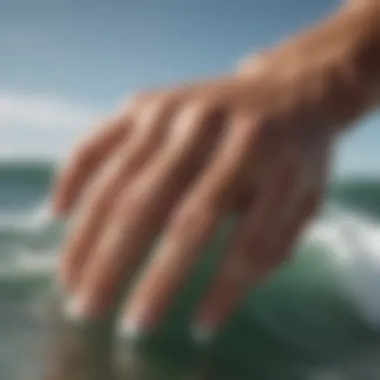
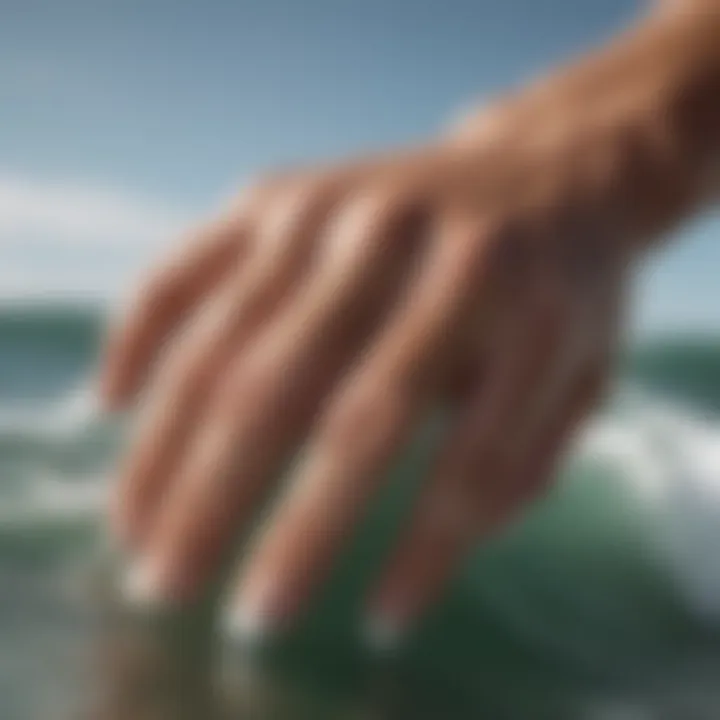
Recognizing these effects is vital. Surfers should be aware of how saltwater interacts with their skin, balancing enjoyment with necessary skin care practices to minimize adverse outcomes.
Practical Considerations for Surfers
Navigating the surf isn’t just about riding waves. It’s also about understanding how to take care of your skin. Here are some practical tips every surfer should consider:
- Hydration is Key: Drink plenty of water before and after hitting the waves. Water intake helps replenish what the skin loses in saltwater.
- Rinse Off: A quick rinse in freshwater after surfing can help remove salt and minimize skin irritation. Don’t let the ocean’s salt linger on your skin for too long.
- Moisturize: Use a good moisturizer after your post-surf rinse. Look for creams that have ingredients like shea butter or aloe vera; they can be very helpful in soothing the skin.
- Protective Gear: Consider wearing gloves when surfing, especially in colder climates. This can act as a barrier and minimize direct exposure to harsh elements.
These thoughtful measures can enhance a surfer’s experience, allowing them to enjoy their time in the water while maintaining skin health. Remember, the ocean is a beautiful force, but it is one that needs to be respected, especially when it comes to skin care.
"Maintaining healthy skin is as crucial as mastering your waves; one supports the other in the world of surfing."
By being mindful of these factors, surfers can extend their time on the board while keeping their fingertips and overall skin in optimal shape.
Health Implications of Fingertip Wrinkling
Fingertip wrinkling isn’t just a harmless quirk that surfaces after a long soak in water. This phenomenon may signal underlying health implications that deserve attention. Understanding these implications is crucial, particularly for individuals like surfers, lifeguards, and outdoor enthusiasts who frequently encounter environments that might aggravate skin conditions. By delving into these concerns, we not only uncover potential dermatological issues but also gain insights into our body’s hydration levels and overall health.
Dermatological Concerns
Wrinkled fingertips can be a telltale sign of various dermatological conditions. For starters, individuals with sensitive skin may find the wrinkling more pronounced due to thinner epidermal layers that react extensively to water exposure. This could lead to a heightened risk of skin irritation or infections, as the barrier protecting the skin may become compromised.
Furthermore, frequent exposure to saltwater can result in additional skin issues. Surfers, for instance, often experience dry skin or conditions like eczema as a consequence of excessive salt exposure combined with lingering moisture. It’s essential for those regularly in the water to invest time in proper skincare routines, such as utilizing emollients that help repair the skin’s barrier.
"Skin integrity plays a vital role in overall health; maintaining its condition is paramount, especially for outdoor adventurers."
In some cases, wrinkled fingertips might also indicate skin aging. With time, and due to cumulative sun exposure, skin loses elasticity and resilience, which can result in fine lines appearing not just on fingertips, but other body areas too. When these lines persist beyond the typical post-washing scenario, it could be wise to consult a dermatologist for tailored advice.
Signs of Dehydration
Dehydration is another hidden worry linked to fingertip wrinkling. When skin remains in contact with water for an extended period, it can lose moisture, leading to a paradox where the skin appears dry and wrinkled despite being wet. This can be particularly alarming for those engaged in water sports, like surfing, where they may not notice the gradual onset of dehydration until it’s significant.
Recognizing the body’s signs of dehydration is critical.
Typical signs include:
- Dry mouth: Often the first alert that something's off.
- Increased thirst: A clear indicator your body needs more fluids.
- Fatigue: A sudden dip in energy levels can signal low hydration.
It’s a good practice for individuals frequently exposed to water to consciously hydrate before and after their activities. Keeping a water bottle handy while surfing or working on the beach serves as a reminder to maintain optimal hydration levels.
In summary, wrinkled fingertips can offer a glimpse into more serious health issues, both dermatological and related to hydration. For surfers and outdoor enthusiasts, understanding these implications allows for better health management, ensuring that skin remains protected and hydrated, which will ultimately enhance their overall experience in natural waters.
Exploration of Related Phenomena
Understanding wrinkled fingertips opens a window into a variety of related phenomena associated with skin changes. This aspect is particularly significant as it not only broadens our comprehension of the fingertip wrinkling itself but also illuminates related skin reactions that occur throughout the body. By exploring these interconnected topics, we can gain deeper insights about skin health, environmental impacts, and even lifestyle factors that could affect overall skin texture and appearance.
Wrinkles in Other Body Areas
Skin is a complex organ that reacts to flavor of external factors, and wrinkling can manifest in several regions of the body. While fingertip wrinkling typically occurs due to prolonged exposure to water, other areas might display similar changes due to different reasons.
- Facial Wrinkles: As we age, facial skin often thins, becoming more prone to wrinkles. Staying hydrated helps fight this, but environmental stressors like sun exposure can take a toll.
- Elbow Creases: Similar to fingertips, skin folds around the elbows can show signs of wrinkling, especially when there is a lack of moisture or in colder weather.
- Knees and Thighs: Some people may notice skin laxity around the knees and thighs over time, due to reduced collagen levels and external damage from weather conditions.
These variations offer an interesting perspective on skin elasticity and how different body parts can react to similar environmental stimuli. Often, it's a telling sign of general skin health and awareness of one's body can lead to better overall care practices.
Comparison with Other Skin Reactions
When comparing fingertip wrinkling to other skin reactions, it’s clear that the skin’s responses can be quite intricate.
- Hyperhydration: Besides just wrinkling, skin can exhibit signs of over-hydration. For instance, when you swim for too long, not only do fingertips wrinkle, but sometimes, areas of the skin in direct contact with water can develop a softer appearance.
- Dermatitis: This condition can mimic wrinkling and can stem from allergies or irritants. In this case, the skin might appear red and inflamed, contrasting the typical grayish hue of wet fingertips.
- Sunburn: Skin damaged by UV rays can also wrinkle, though not in the same acute manner as when wet. This happens over time, leading to premature aging and a leathery texture.
"Skin changes can be an indicator of various underlying conditions; being observant can help recognize when a change is a warning sign or just a normal response to environmental factors."
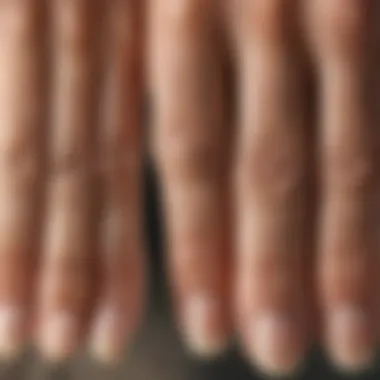
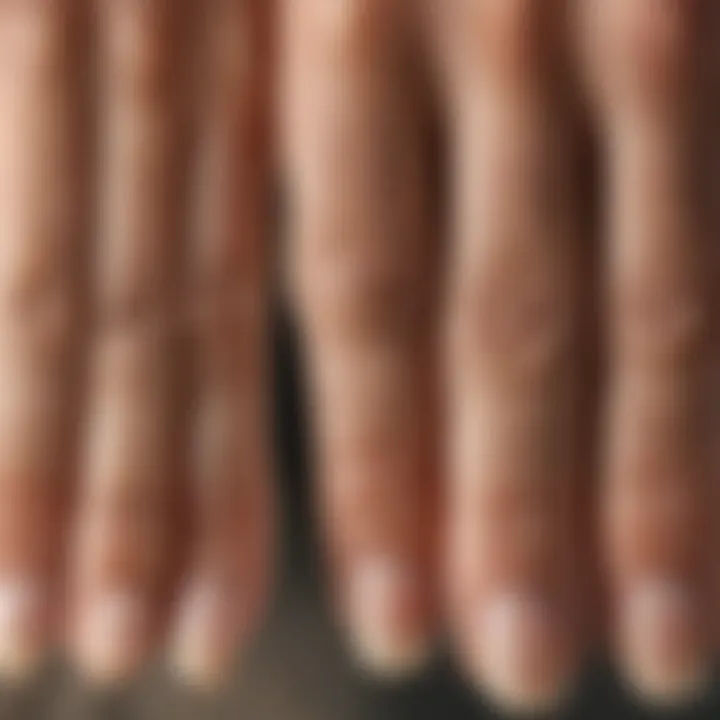
By drawing parallels between these different skin reactions, we can better appreciate the unique characteristics of fingertip wrinkling. These comparisons emphasize the need for an informed approach to skin care, as what applies to one area may not always hold true for another.
Practical Advice for Managing Fingertip Wrinkles
Wrinkled fingertips, while often seen as a mere curiosity, can serve as an indicator of various factors, from hydration levels to professional habits. In this section, we aim to demystify the best strategies for managing fingertip wrinkles effectively. In doing so, we can illustrate how simple changes can lead to significant improvements in skin health and functionality, particularly for those frequently exposed to water or harsh environmental factors.
Effective Hydration Techniques
Hydration is key when it comes to maintaining the elasticity and health of skin. For surfers or individuals who are frequently in water, understanding proper hydration techniques can help minimize the appearance of wrinkled fingertips and promote overall skin vitality. Here are some essential tips:
- Drink Plenty of Water: It sounds simple, but maintaining internal hydration is crucial. Aim for at least eight glasses a day, especially before and after surf sessions.
- Use Humidifiers: If you're spending time in dry environments, using a humidifier can help retain moisture in the air, benefiting your skin.
- Moisturize Regularly: After exposure to saltwater or chlorinated pools, it’s vital to apply high-quality moisturizers. Look for lotions containing glycerin or hyaluronic acid, as they attract moisture to the skin.
"Keeping our skin hydrated is like watering a plant; without it, we see the effects pretty quickly."
- Avoid Hot Showers: Hot water can strip away moisture, so it's better to have lukewarm showers, especially post-surf. This way, you can keep your skin from drying out more than necessary.
Skin Care Practices for Surfers
Surfers face unique challenges when it comes to skin care. Elements like sun exposure, saltwater, and wind can wreak havoc on skin integrity, contributing to wrinkly fingertips. Here are tailored practices for surfers:
- Apply Sunscreen: Use broad-spectrum sunscreen on your hands and fingertips before hitting the waves. Even short exposure can cause sun damage, leading to premature aging.
- Limit Exposure: Try not to keep your hands in water for prolonged periods. Plan your surfing sessions and minimize downtime with wet hands—remember, it’s better for your skin in the long run.
- Post-Surf Rinse: After surfing, make sure to rinse off any saltwater or chlorine immediately. This helps to limit their drying effects on your skin. Following that up with a moisturizer is also helpful.
- Consider Barrier Creams: Products specifically designed to create a barrier between your skin and the elements can be quite beneficial. Products like zinc oxide creams can help shield against both sun and water damage.
Incorporating these practical approaches into daily routines not only tackles wrinkled fingertips but also promotes long-term skin health. By addressing hydration effectively and adopting tailored skin care practices, even avid surfers can keep their fingertips looking and feeling their best.
Investigating Scientific Studies on Fingertips
Understanding wrinkled fingertips involves peeling back layers of the biological and environmental factors at play. Scientific studies in this area shed light not just on the appearance of our fingertips, but also help to illuminate their functional significance in various activities—surfing being a prime example. This section explores why examining these scientific findings is crucial for individuals who often find themselves in environments that exacerbate fingertip wrinkling, such as surfers, beach lifeguards, and marine biologists.
First, the studies provide a window into the body’s adaptive mechanism. When fingers wrinkle, they aren't merely reacting to the elements; they are engaged in an evolutionary response designed to enhance grip. This is particularly relevant in water-heavy environments. With this knowledge, one can appreciate the adaptive function of wrinkled fingertips beyond surface-level aesthetics, turning what could be a mere nuisance into a fascinating aspect of human physiology.
Additionally, recent findings underscore the potential dermatological implications associated with fingertip wrinkling, which can help inform care practices for those regularly exposed to harsh environmental conditions. Understanding these studies equips beach instructors and lifeguards to better manage skin care among their students and clients, promoting long-term skin health. Exploring scientific research offers valuable data that can enhance both lifestyle choices and professional practices in demanding occupations.
Current Research Findings
Current research in the realm of fingertip wrinkling highlights several intriguing dimensions. For starters, one significant study published in the journal Experimental Physiology notes that prolonged exposure to water alters the skin's outer layer, leading to increased wrinkling in the fingertips. Researchers found that this change improved grip in wet conditions, which is particularly relevant for surfers and those involved in aquatic activities.
Moreover, the research suggests a clear alignment with nerve function. The wrinkling of skin in response to water exposure appears linked to the autonomic nervous system, hinting at a deep-rooted evolutionary response mechanism. This correlation not only maps the physiological responses but also paints a picture of human adaptability that warrants further exploration.
Another line of inquiry focuses on age-related changes in fingertip wrinkling. Studies have shown that older adults experience more pronounced wrinkling due to both structural skin changes and reduced nerve function. Such findings can illuminate advice on skin care regimens for different age groups, adding a tailored approach for surfers who might seek ways to maintain skin health as they age.
Future Research Directions
As we look ahead, future research in the area of wrinkled fingertips presents ample opportunities. One area ripe for exploration involves the relationship between fingertip wrinkling and various skin conditions. Understanding whether individuals with eczema or dermatitis experience differing reactions to water exposure could provide greater insight into effective interventions.
Another compelling avenue for study lies in the use of technology to quantify the effects of water exposure on wrinkling in real-time. Innovations like wearable sensors could aid both researchers and practitioners in gathering data on how long certain activities lead to fingertip changes, contributing to personalized skin care advice for surfers, lifeguards, and other outdoor enthusiasts.
Moreover, interdisciplinary studies that merge biology, environmental science, and even psychology could yield fascinating insights. Investigating how environmental stressors interact with skin's physiological responses is key to grasping both immediate effects on skin health and long-term implications for those frequently exposed.
Through these lines of inquiry, scientists can begin to construct a comprehensive understanding of how fingertip wrinkling operates in both everyday life and specialized contexts. With every bit of knowledge, we move closer to demystifying not just a fleeting phenomenon, but an essential aspect of our skin's adaptation to the world around us.
Ending: Reflections on Fingertip Wrinkling
As we wrap up our exploration into the world of wrinkled fingertips, it's crucial to reflect on what we've learned and why it matters. Fingertip wrinkling is more than just a curious side effect of prolonged water exposure. Understanding its roots in biology, the various environmental contexts, and the significance it holds in specific activities, particularly for surfers and other outdoor enthusiasts, reveals a rich tapestry that intertwines science with everyday life.
Summarizing Key Insights
From our discussions, we can draw several key takeaways:
- Biological Basis: The phenomenon is largely driven by the nervous system as a response to wet conditions, a clear example of the body's adaptive mechanisms.
- Environmental Factors: Water, temperature, and humidity all play vital roles in the appearance of wrinkled fingertips, affecting not just aesthetics but also potentially influencing grip and performance in water sports.
- Cultural Context: Wrinkled fingertips aren't merely a biological occurrence; they carry significance in various cultures, often associated with leisure activities like surfing, forming a connection between nature and human experience.
Understanding these elements can better equip individuals, such as surfers, instructors, and marine biologists, to handle the implications of fingertip wrinkling effectively. Awareness of its causes and effects allows for more strategic engagement with aquatic environments.
Importance in Everyday Life
The significance of fingertip wrinkling extends beyond science to practical realms of daily existence. For surfers and others spending time in water, recognizing the physiological effects can lead to enhanced performance:
- Adaptive Advantage: Wrinkled fingertips may improve grip on wet surfaces, a fact surfers should embrace to maximize their skill on the board.
- Health Awareness: Knowing how fingertip wrinkling links to hydration can guide better skin care routines, ensuring the balance between performance and health remains.
- Cultural Connection: It's essential for individuals engaged in beach cultures to appreciate the aesthetic nuances of wrinkled fingertips. This connection breeds a deeper respect for their environment and their bodies.
By reflecting on these aspects, individuals not only gain scientific insights but also foster a more profound appreciation for their experiences in water-related activities.















